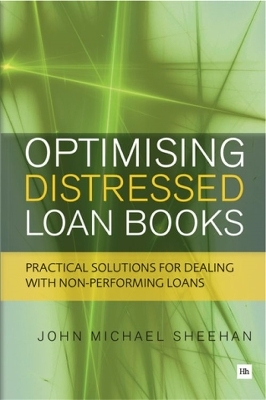
Optimising Distressed Loan Books
Harriman House Publishing (Verlag)
978-0-85719-129-8 (ISBN)
- Titel ist leider vergriffen;
keine Neuauflage - Artikel merken
Dealing with distressed loans is different to other banking activities. Normal bank processes, decision-making structures, management techniques and investment philosophies are geared to making money in buoyant markets. However, these same characteristics mean that in a downturn banks are poorly equipped to deal with working-out distressed loan portfolios. This is problematic and costly for banks, as there are billions of dollars to be made from the resolution of defaulted loan books, if only they can harness the skills for doing this effectively. In this unique new book, John Michael Sheehan explains why financial institutions have failed to resolve distressed loan books profitably in the past and describes the solutions they can put in place to improve this in the future. Sheehan builds on 20 years' experience of hands-on asset monetisation, loan portfolio servicing and debt work-out to describe how banks can learn to convert the dredges of loan defaults into profits. Written in a clear and approachable style, illustrated throughout and punctuated with insightful real-life case studies, Sheehan provides a highly accessible guide to this technical area.The book is divided into three parts.
The first section analyses how and why banks fail to maximise distressed recoveries. The second section is a practical, basic training manual of techniques, systems and processes that will explain to investors or lenders how to go about earning back their losses and, in many cases, clearing amounts greater than par. The final section analyses lessons from previous crises and proposes how in the future financial institutions can improve their distressed loan resolution practices. Bank executives and officers, their advisors, loan servicers, investors, and government-sponsored entities will be able to use this book as a working tool to assist them in working-out loans and retaining the rewards from this process. Accountants, administrators and ratings agencies should find this book to be an extremely useful source of reference, whilst regulators, academics and students will also find it will improve their understanding of the secretive distressed debt industry and therefore the financial system.
John Sheehan followed financial crisis around the world for a decade with a well-known US investment bank, specialising in distressed debt acquisition and loan servicing, corporate restructuring, real estate investment, lending and structured finance. Amongst these, distressed debt investment and work-out was one of the most profitable business lines earning extraordinary returns on capital invested. John's first introduction to this business was undertaking real estate advisory and collateral valuation of non performing loan portfolios. From here he advanced into loan pricing, portfolio negotiation and acquisition from financial institutions and governments. Ultimately, he progressed into loan servicing and managing large work out platforms, specialising in newly opened jurisdictions. His early career was spent in the UK and Western Europe. He worked in Asia Pacific after the 1997 crisis until 2005 and thereafter back in Europe and then Latin America gaining global experience through loan transactions in Hong Kong, Singapore, Malaysia, Indonesia, Thailand, the Philippines, Taiwan, Korea, India, Australia, Brazil, Columbia, Portugal, Spain, Germany, Poland, the Czech Republic, Greece, Turkey and Israel. John now advises financial institutions, administrators and investors on the subject of non-performing loans and undertakes specialised training courses for loan work-out units and distressed debt asset managers. He is a popular public speaker in Asia and Europe. He holds a B.Sc. degree in Estate Management and is a Fellow of the Royal Institution of Chartered Surveyors.
About the Author Acknowledgements Preface Introduction PART I: THE DISTRESSED DEBT PROBLEM 1. How Distressed Debt Escalates Out Of Control 2. Why Banks Fail To Maximise Distressed Collections PART II: DISTRESSED DEBT SOLUTIONS 3. Structure Solutions 3.1 Response to crisis 3.2 Internal work-out 3.3 Bad banks 3.4 Special servicers 3.5 Selling off loan books 4. Preparation And Planning Solutions 4.1 Core concepts and components 4.2 Resources for different loan types 4.3 Preparing the groundwork for resolutions 4.4 Optimising collection distribution 5. Asset Management Solutions 5.1 Skill sets for distressed asset managers 5.2 Managing asset managers 5.3 Controlling the resolution process 5.4 The asset manager toolkit 5.5 Measuring asset manager performance 6. Borrower Solutions 6.1 Dealing with defaulted borrowers 6.2 Refinancing and restructuring 7. Collateral Solutions 7.1 Credit bidding 7.2 Real estate valuation: making appraisals work 7.3 Valuation benchmarking 7.4 Real estate development - credit blind spot 7.5 Real estate market recovery 7.6 Finishing Incomplete real estate developments PART III: PAST LESSONS, FUTURE IMPROVEMENTS 8. Lessons From Previous Crises 9. New Initiatives to Preserve Capital and Increase Returns 10. Recent Developments In Distressed Debt 11. Conclusion Glossary of Terms Appendix Index
| Erscheint lt. Verlag | 19.9.2011 |
|---|---|
| Zusatzinfo | black & white illustrations |
| Verlagsort | Petersfield |
| Sprache | englisch |
| Maße | 156 x 234 mm |
| Gewicht | 381 g |
| Themenwelt | Recht / Steuern ► EU / Internationales Recht |
| Wirtschaft ► Betriebswirtschaft / Management ► Finanzierung | |
| Betriebswirtschaft / Management ► Spezielle Betriebswirtschaftslehre ► Bankbetriebslehre | |
| ISBN-10 | 0-85719-129-2 / 0857191292 |
| ISBN-13 | 978-0-85719-129-8 / 9780857191298 |
| Zustand | Neuware |
| Informationen gemäß Produktsicherheitsverordnung (GPSR) | |
| Haben Sie eine Frage zum Produkt? |
aus dem Bereich


